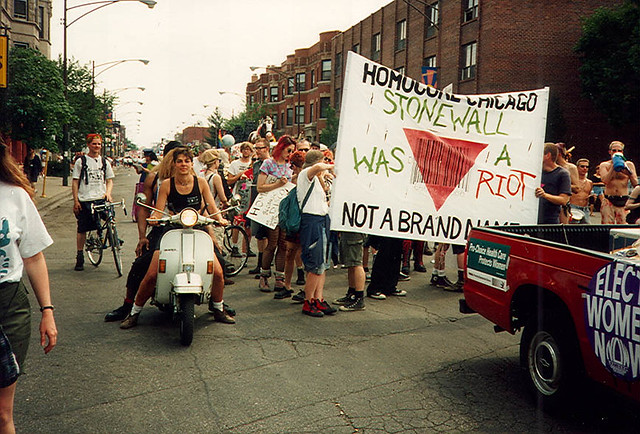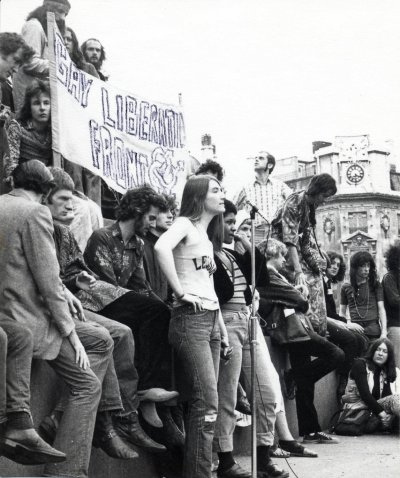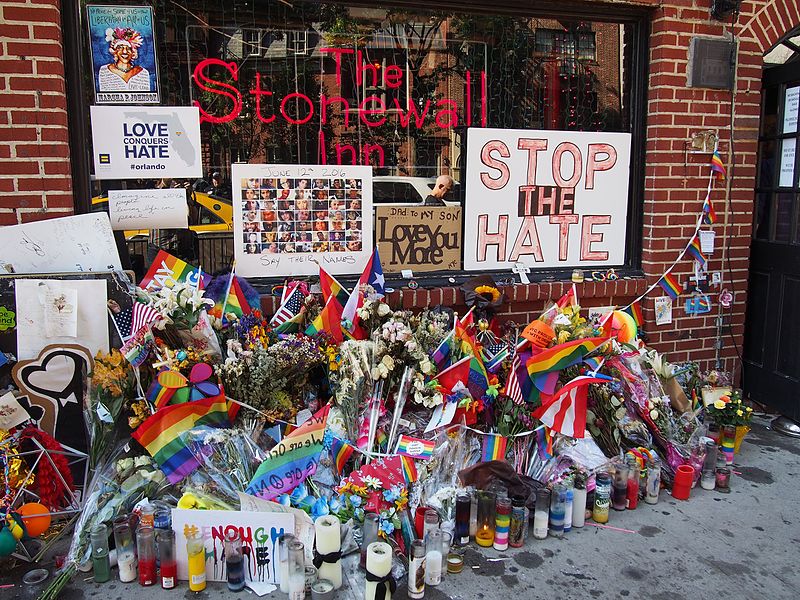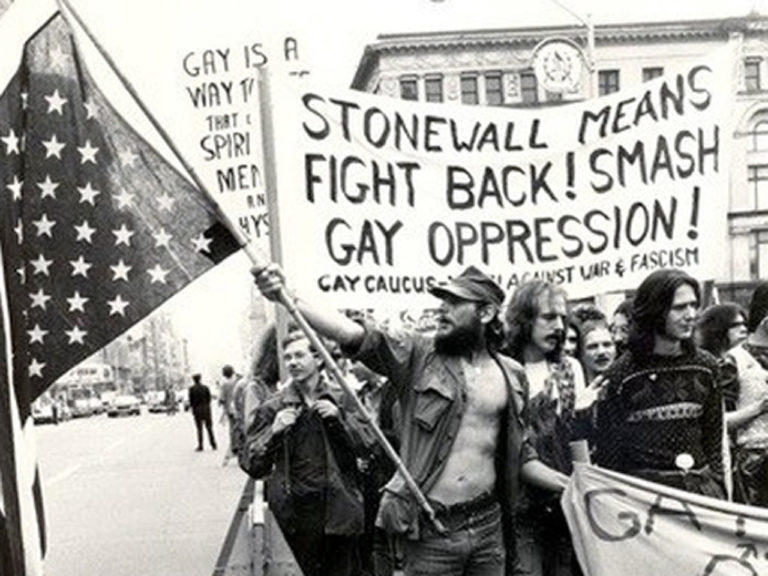On 28 June 1969, a riot just outside the Stonewall Inn bar, located on Christopher Street in Greenwich Village, New York City, marked a turning point in the fight for the emancipation of LGBTQ people. That night, the bar was raided by the police, which was all too common at the time with gay bars. But this time, gay people didn’t let the police walk over them. They stood up to the NYPD in an unprecedented weekend of rioting. This courageous act transformed the movement and led to thousands of LGBTQ people coming “out of the closet, into the streets!” It is important to revisit these events and draw the main lessons for today.
LGBTQ struggle before Stonewall
For many, the Stonewall riots were like lightning from a clear blue sky. But the fight for LGBTQ liberation had started long before.
Working-class LGBTQ people were—and still are—among the most oppressed layers of American society. It was totally legal at the time to dismiss someone from a job because of sexual “deviance”, with homosexuality at the top of the list of these so-called deviances. Doctors considered homosexuality a mental illness, and recommended intensive talk therapy or electroshock treatment. Homosexuals were sometimes even castrated against their will. Sodomy was punished with severe prison sentences and homosexual behaviour in public was illegal.
In the epoch of “McCarthyism”, anticommunism and homophobia were closely intertwined. McCarthy himself had jokingly told the press that “if you want to be against McCarthy, boys, you’ve got to be a communist or a cocksucker.” Homosexuals were considered a “security threat” because of their alleged “lack of emotional stability” and the “weakness of their moral fibre” and, therefore, had to be purged from the American government. In this context of oppression and repression, LGBTQ people were forced to hide their sexual orientation and/or gender identity.
Interestingly, the first organisation to defend homosexual rights (if we exclude the Chicago Society for Human Rights which lasted only a few months in 1924) was founded by a communist, Harry Hay in 1950, and was called the Mattachine Society. This organisation was the first of what was called, at the time, the “homophile” movement.
However, the Communist Party of the USA (CPUSA), to which Hay belonged, didn’t accept homosexuals and lesbians as members. Homophobia in the CPUSA was the result of the shameful acts of Stalin’s clique in the USSR, which had criminalised homosexuality in the country in 1934 after it had been decriminalised in 1922 under Lenin and Trotsky. Homophobia spread through the communist parties throughout the world.
 The fight for LGBTQ liberation had started long before Stonewall, but the riots were a turning point / Image: Flickr, QZAP
The fight for LGBTQ liberation had started long before Stonewall, but the riots were a turning point / Image: Flickr, QZAP
In this particular situation, in which Hay had the firm intention of continuing his gay activism while the CPUSA refused to admit homosexuals and lesbians in the party, Hay proposed his own expulsion from the party. He explained: “Since homosexuals were forbidden membership in the Party, according to its own constitution, I felt that those members in California who knew my Party work would know I had never endangered Party security. But, were this matter to be aired in the People’s World or the Daily Worker, members in other states might feel the Party had been lax about safeguarding the membership. I felt that a proposal for my expulsion would exonerate the California Party in their eyes, and that was the important thing.” Hay was therefore expelled.
Thus, the American communists missed a golden opportunity to be at the vanguard of the LGBTQ liberation movement. We can see here the immeasurable harm that the Stalinist degeneration did to the communist movement. Needless to say, the homophobia of the Stalinists has nothing to do with what genuine Marxists defend.
The Mattachine Society was the main organisation fighting for homosexual rights during the 1950s. In 1955, the Daughters of Bilitis was created. It was less radical than Mattachine and was more of a support group for lesbians. Both organisations remained on the margins of society; at the end of the 1950s, Mattachine had 230 members, while the Daughters of Bilitis had 110.
As with any movement for the emancipation of the oppressed, a struggle of ideas, perspectives and methods was waged. The gay liberation movement was no exception. Some advocated radical methods, while others looked to convince liberal politicians and “experts”. Ultimately, this reflects different class perspectives in the movement.
There has always been a layer of the movement that aims to keep it within “safe” channels, i.e., keep the movement from going “too far” and challenging the entire capitalist system and its political representatives. Some didn’t want a “movement” from the masses at all. For example, Curtis Dewees from Mattachine New York proposed that the movement be led “by pillars of the community”, the reason being that “strategically placed individuals can do more to change public opinion in the next decade than many times that number of persons picked at random from society”. The Stonewall events would show how wrong this perspective was as hundreds of people “picked at random from society” would change the course of history more rapidly than all the liberal politicians together.
The gay activists of the time faced many obstacles, most notably the lack of participation of LGBTQ people themselves. Indeed, many homosexuals didn’t want people to know their true sexual orientation. They even feared that activists dressed in “ordinary clothes” would lead to them being suspected of homosexuality. The argument was: “We don’t want people to know we [look like] everybody else. As long as they think everyone’s a screaming queen with eyelashes, we’re safe. We’re not suspected.” Again, the Stonewall riots would contribute to change this.
“Gay power!”
At the time of the Stonewall riots, LGBTQ people were constantly targeted by the police. They used what was called entrapment: policemen would dress as civilians and make sexual advances toward homosexuals in a gay bar or other public areas. If it worked, the policemen would then use this as justification to arrest the homosexual. Between 1959 and 1963, between 1,000 and 1,300 people were arrested every year in New York City for “homosexual activities”.
Gay bars were often the only places LGBTQ people could feel secure. But they could not completely escape oppression. Indeed, police raids in gay bars were a routine matter. During those raids, policemen would arrest people found to be “cross-dressing”, which was illegal at the time. In 1959, the State Liquor Authority closed a dozen bars in New York because they served alcohol to homosexuals, which was also illegal. Only in 1966 would homosexuals be allowed to be served alcohol and dance in public!
Seeing an opportunity to expand their operations, the Mafia took control of the gay bar “industry”—the Stonewall Inn was one of several bars controlled by the Mafia. These criminals took advantage of their control to serve over-priced, diluted drinks and to blackmail patrons who wished to keep their sexual orientation secret. The homosexual population was an immense source of profits for the Mafia in the 1960s. But in the police raids, the Mafia itself was not persecuted; the police let them know about the raids, and the Mafia would pay corrupt officers to allow it to continue running its businesses.
In the case of Stonewall, under the pretext of fighting the Mafia, the police attempted to close down the bar. The first raid occurred on Tuesday 24 June 1969, to gather evidence against the bar owners. According to Ronnie Di Brienza, who was there at the time, the general feeling was that this was just another routine harassment raid where corrupt policemen would ask for money from the Mafia. But he noted that, for three days, the frustration was clearly felt throughout the community: “Predominantly, the theme was ‘This shit has got to stop!’”
Then, early in the morning on Saturday 28 June, the cops led a second raid at the Stonewall Inn. The “cross-dressers” were kept together in order to be “examined” in the bathroom, a humiliating procedure to verify whether they were breaching the reactionary laws. But the operation didn’t go as planned. This time, those present refused to collaborate with the police. The patrons who were getting out of the bar, instead of leaving quietly as would normally happen, started to gather at the entrance to see what was happening to their friends inside.
While employees and “cross-dressers” were being put in a squad car, the crowd started booing and mocking the police. A lesbian was pushed outside the bar and thrown into a police car. She escaped twice, and it was reported that she yelled at the crowd, “Why don’t you guys do something?” Then, as she was violently thrown back into the car, demonstrators started to shout “Police brutality! Pigs!” at the police. The riot had begun.
The crowd started to insult the police, throw pennies, bottles and even cobblestones at them. After decades of humiliation, oppression and exploitation, they were pouring all their accumulated anger onto the police.
The cops were forced to retreat and to barricade themselves in the Stonewall Inn itself under a shower of empty bottles. A participant said: “In the civil rights movement, we ran from the police, in the peace movement, we ran from the police. That night, the police ran from us, the lowliest of the low.” The LGBTQ people present that night dispelled the widespread myth that presented them as weak, vulnerable and passive. They screamed “gay power!” and “we want freedom!” at the shocked and scared policemen. Only the arrival of the riot police allowed the forces of repression to put an end to this historic night.
The next day, news of the riot spread like wildfire. On the black, wooden boards that replaced the broken windows of the Stonewall Inn, slogans were written in chalk: “Support Gay Power—C’mon in girls”, “They want us to fight for our country. But they invade our rights” and “Gay Prohibition Corrupt Cop$ Feeds Mafia”. That night, a spontaneous gathering in front of the Stonewall Inn occurred. Around 2,000 people assembled and sang the same slogans as the previous night, along with other ones such as, “Christopher Street belongs to the queens!” and “equality for homosexuals!” The rally led to another confrontation with the police and the riot cops were again called as reinforcement to put an end to it.
The Stonewall riots are remembered today because they were the moment the community said “enough!” In the words of one of the participants: “We’ve been harassed for doing nothing more than having our fun; not hurting anybody else. Well, the ‘gay riots’ mean we’re not going to take it anymore.”
Radicalisation
 Demonstration by the Gay Liberation Front (GLA) / Image: LSE Library
Demonstration by the Gay Liberation Front (GLA) / Image: LSE Library
The riots immediately sparked an unprecedented wave of gay activism. Following the riots, a layer of activists in the Mattachine Society of New York (MSNY), radicalised by the events, wanted the movement to be more militant and to ally itself to the rest of the left in the fight against oppression of blacks and against the Vietnam War. An action committee was formed in the MSNY and members of the Daughters of Bilitis joined in. But this committee quickly entered into conflict with the more conservative leadership of the organisation, most notably Dick Leitsch. In a heated meeting of the MSNY, a participant recounted that Leitsch said he wanted the movement to “retain the favor of the establishment.” A heated debate followed, in which Leitsch was shouted down by an activist saying, “All the oppressed have got to unite! The system keeps us all weak by keeping us separate.”
Later, the conservative faction even went as far as opposing a commemoration demonstration for the riots, because such a display of “gay power” would risk antagonising the liberal allies on the city’s government! There are undoubtedly similar elements in the LGBTQ movement today who want to keep the Pride demos and movement generally within channels that are safe for the establishment.
In the end, the action committee formed a separate organisation, the Gay Liberation Front. In an article published in the Rat announcing the founding of the GLF and published in the form of an interview, the answer to the question, “What is the Gay Liberation Front?” was as follows:
“We are a revolutionary group of men and women formed with the realisation that complete sexual liberation for all people cannot come about unless existing social institutions are abolished. We reject society’s attempt to impose sexual roles and definitions of our nature...”
“We, like everyone else, are treated as commodities. We’re told what to feel, what to think… We identify ourselves with all the oppressed: the Vietnamese struggle, the third world, the blacks, the workers… all those oppressed by this rotten, dirty, vile, fucked-up capitalist conspiracy.”
This radicalisation to the left within the LGBTQ movement was not an accident. Whole layers of American society, especially the youth, were coming to the conclusion that capitalism and the various forms of oppression are linked and that we need to fight capitalism to liberate the oppressed. Organisations similar to the GLF were formed in other countries such as Britain, Canada, France, Italy, etc. The GLF in the US was short-lived as they stopped being active in 1972. Nevertheless, their call to link up the struggle of LGBTQ people with workers and oppressed in general must be taken up today. This is what the Marxists of the IMT are trying to do!
Revive the militant tradition
The first commemoration of the Stonewall riots was held a year later, on 28 June 1970. To the great delight of the organisers, thousands of people participated in the demonstration. One of them said: “This was the moment when the closet door was actually opening and the gay community was coming out into the light.” From then on, the Pride march would become a tradition that continues to this day. Not the parliamentary tricks and gentle pressure on liberals, but the heroic action of thousands of people fighting against the NYPD was what gave a great impetus to the fight for LGBTQ emancipation. This is what allowed steps forward to be made.
Unfortunately, since then, Pride has moved away from its militant roots. The annual demonstration, first held under the “gay power” slogan, is today nothing more than a huge street party at which capitalist politicians like Justin Trudeau and Hillary Clinton feel welcome. Even the police show up at demonstrations in uniform—the same institution that oppressed the LGBTQ people in the Stonewall years, and which continues to do so today. This year, cynically sensing an opportunity to burnish their image, the NYPD went as far as apologising for their treatment of LGBTQ people at the time!
The corporatisation of Pride has also increased year after year. Big business sponsors the marches and big banks add rainbows to their logos. In 2017, New York City Pride had no fewer than 61 sponsors! Witeck Communications, a communications firm that specialises in LGBTQ outreach, calculated in 2016 that the purchasing power of LGBTQ people in the U.S. was $1 trillion. Herein lies the material interest of these companies to sponsor and co-opt Pride.
Despite the sheer hypocrisy and corporate cash grab, Pride’s popularity is nonetheless a remarkable testament to the change in public opinion regarding LGBTQ people. While all of bourgeois society used to be impregnated with profound homophobic prejudices, today, many of these prejudices have diminished. In 2004, 60 percent of Americans were opposed to same-sex marriage. Today, 61 percent of Americans are now in favour. What a remarkable reversal!
 The fight for equality must be linked to a programme of fighting capitalism and for socialism / Image: Rhododendrites
The fight for equality must be linked to a programme of fighting capitalism and for socialism / Image: Rhododendrites
The march towards equality has been strenuous and the gains for LGBTQ people took a painfully long time to come about. We had to wait until 2003 for all anti-sodomy laws to be struck down by the Supreme Court in the U.S., and until 2015 for same-sex marriage to be legalised throughout the country. Moreover, the fight is far from over. Despite the fact that many formal rights have been won, LGBTQ people remain one of the most oppressed layers of society. According to a 2017 study, LGBTQ people are 120 percent more likely to be homeless than straight people. Furthermore, according to the GLSEN 2017 report, 70.1 percent of LGBTQ students experienced verbal harassment at school based on sexual orientation. For the first time since 2007, school victimisation based on gender expression and sexual orientation has remained steady or increased. According to the Williams Institute, LGBT people suffer nearly double the unemployment rate of non-LGBT individuals, and the percentage of those suffering from “food insecurity” is 27 percent for LGBT against 15 percent for non-LGBT people. Data collected by the FBI published in 2016shows that LGBTQ people are more likely than any other minority to be the target of a hate crime.
As the saying goes, you can’t eat democracy. Although many democratic rights have been won, LGBTQ people still face heavy barriers towards economic and social equality.
And even the gains of the past are under threat. We see this very clearly with the Trump administration, which implemented several oppressive measures against LGBTQ people and trans people in particular. For example, Trump issued a ban on trans people serving in the military and removed federal protections for trans students that allowed them to use the bathroom that matches their gender identity. In May of this year, Trump announced a new rule that would allow federally funded shelters to deny people admission on religious grounds, or force transgender women to share bathrooms and sleeping quarters with men. Also, Trump proposed to no longer include gender identity as a form of sex discrimination. This would allow health workers to refuse to perform procedures such as gender reassignment surgery, for instance. All these disgusting attacks are evidence that as long as we allow capitalism to rule, our basic rights will never be secure.
Today, the movement needs to revive the radical spirit of the Stonewall riots. Many people are sickened by the hypocrisy of all those capitalist politicians who show up at Pride but continue the business-as-usual austerity measures or turn a blind eye to the inequality of conditions suffered by LGBTQ people. They are sickened by the presence at Pride of the cops and of the big businesses that exploit all of us. We cannot count on any of these people in the fight for emancipation.
Today more than ever, the fight for equality must be linked to a programme of fighting against capitalism and for socialism. The labour movement must take up the fight for LGBTQ rights, and link it to a radical transformation of society. By expropriating the 1 percent, we could use the immense resources that they are hiding in their bank accounts to satisfy the needs of all. Once all the productive capacity of society is in the hands of the working class as a whole, we will be able to offer decent wages, conditions, housing, health care, etc., for all. Democratic control of workplaces and schools would allow us to fight discrimination and prejudices by holding all those in teaching or leading positions accountable. LGBTQ groups would be allowed the resources to address the specific needs of LGBTQ people. As the GLF correctly explained: “complete sexual liberation for all people cannot come about unless existing social institutions are abolished.” And, we would add, until they are replaced by a workers’ government and socialism.
Sources
Ann Bausum, Stonewall: Breaking Out in the Fight for Gay Rights, Penguin, New York, 2015.
David Carter, Stonewall: The Riots that Sparked the Gay Revolution, St. Martin’s Griffin, New York, 2010.
David Eisenbach, Gay Power: An American Revolution, Carroll & Graf, New York, 2006.

